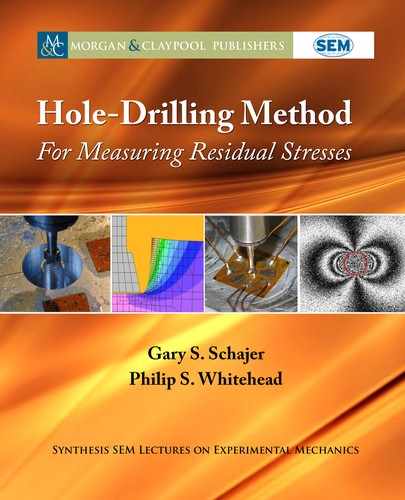
5.3. CALIBRATION CONSTANTS 91
Table 5.1: Placement of the principal angle ˇ
Q Q >
0 Q = < 00
T < 0
45°
< β < 90° 45° 0° < β < 45°
T = 0
90°
undefi
ned
0°
T
> 0
-90° < β < -45° -45° -45° < β < 0°
5.3 CALIBRATION CONSTANTS
In the early years of hole drilling, the numerical values of the calibration constants Na and
N
b were
evaluated through experimental measurements on specimens with known stresses. e values
of the constants vary with hole depth and diameter, also the size and geometrical arrangement
of the strain gauge rosette used for the measurement. Rendler and Vigness (1966) were the
first to note that the strain response depends on the ratio of the hole dimensions to the strain
rosette size, for example, as indicated by the mean diameter of the strain gauge circle. is
observation introduced the concept of normalization relative to rosette size so that calibration
constants could be used with different sizes of strain gauge rosettes, providing that the rosettes
are geometrically similar. is is the case with the “Type A” rosettes specified in ASTM E837,
which are available in 1/32”, 1/16”, and 1/8” nominal sizes. It is now standard practice to quote
calibration constants in terms of hole depth and diameter as fractions of the mean diameter of
the strain gauge rosette.
In modern practice, the calibration constants are evaluated using finite element compu-
tations. e results are more consistent and reliable than experimentally derived values. In ad-
dition, the computational approach can evaluate calibration constants for stress states that are
difficult or impossible to create experimentally. e fundamental analytical procedure for deter-
mining hole-drilling calibration constants uses an approach independently introduced by Boiten
and ten Cate (1952) and Schajer (1981). It is essentially an application of Bueckner’s Principle,
which was stated in 1958 for crack stress problems and which states “Any [elastic] crack or
notch problem can be reduced to one where the external load appears in the form of tractions
distributed over the faces of the crack.” Figure 5.2 illustrates the procedure for hole-drilling
computations.
Figure 5.2a schematically shows a cross-sectional view of the stress state at the measure-
ment location before the hole is drilled. e diagram seems to show the state after the hole has
been drilled. However, the original undrilled stress state has been restored in the surrounding
material by applying the originally existing stresses at the hole boundary.
Figure 5.2c represents the stress state at the measurement location after the hole has been
drilled. As is the case in practice, the hole boundary is stress free and only the far-field is stressed.
Using the principle of superposition, the stress state in Figure 5.2b can be added to the “before
drilling” stress state in Figure 5.2a to create the “after drilling” stress state Figure 5.2c. us, a

92 5. STRESS COMPUTATIONS
+ =
(a) (b) (c)
Figure 5.2: Superposition of stress states to evaluate effect of hole-drilling stress relief (from
Schajer (1981)).
finite element analysis of the stress state in Figure 5.2b will model the local deformation caused
by the hole drilling process and will therefore directly provide the calibration constants Na and
N
b.
Apart from its computational convenience, the superposition in Figure 5.2 importantly
demonstrates that the Hole-Drilling Method provides a localized measurement. It measures the
residual stresses that originally existed at the hole boundary, even though the actual measure-
ments are made over a much more extended area in the surrounding material. us, while it is
necessary for the original residual stresses to have been uniform within the diameter of the hole,
it is not required that they were also uniform outside the hole, for example, over the strain gauge
area in Figure 5.1. is observation allows localized residual stress measurements to be made,
for example in a weld, where the drilled hole must be kept within the weld metal but the strain
gauges may be allowed to overlap into the adjacent material.
Hole-drilling calibration constant Na relates the hydrostatic stress P to the hydrostatic strain
p. As seen from Equation (5.4), there is no variation with angle , so an axisymmetric 2D analysis
is sufficient to provide a full solution for this case. Figure 5.3 shows an example finite element
mesh used to model the cross-section shown in Figure 5.2b. A pressure load is applied along the
hole boundary to represent the residual stresses. e far-field boundary has no applied stresses,
but it is important that it realistically models the far-field boundary conditions. is can be done
by modeling a cross-section extending to a very large radius. Recent work by Baldi has shown
that good results can be achieved while using a much smaller outside radius by adding a region
of high stiffness at the distant boundary to represent the effect of an “infinite” far-field.
It happens that a similar 2-D approach can also be used to evaluate hole-drilling cali-
bration constant
N
b, which describes the response to the shear stresses Q and T . In this case,
Equation (5.4) indicates a cos 2 and sin 2 variation with angle. Since these relationships are
explicitly known, there is no need to discretize them, for example, through a 3-D finite element
analysis. Instead, 2-D “harmonic” elements that have the cos 2 and sin 2 variations built into
them can be used. is approach, using a separate 2-D finite element analysis for each of the
calibration constants Na and
N
b, gives substantial computational advantage over a 3-D analysis
because it uses far fewer elements, so allowing more detailed discretization and hence greater
..................Content has been hidden....................
You can't read the all page of ebook, please click here login for view all page.
